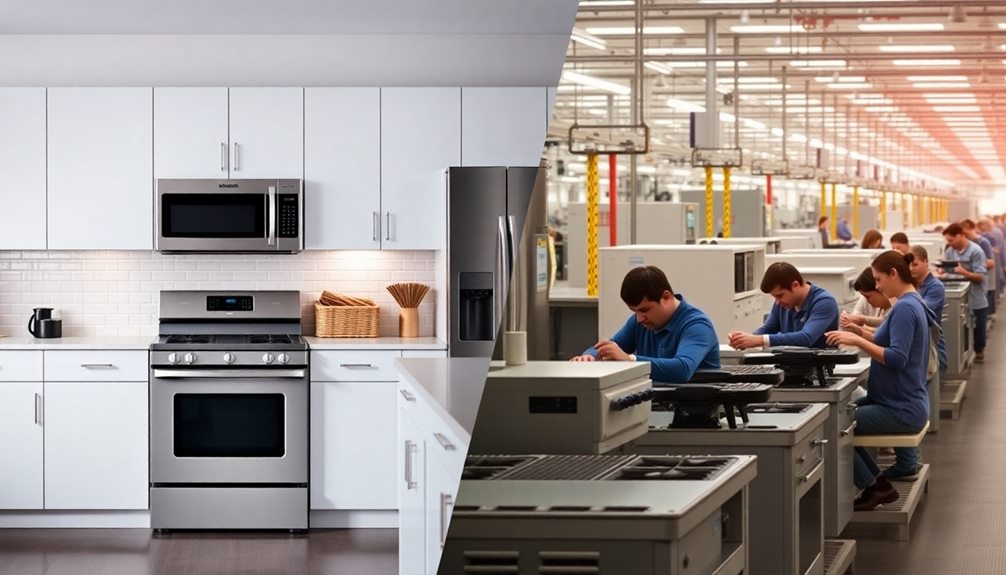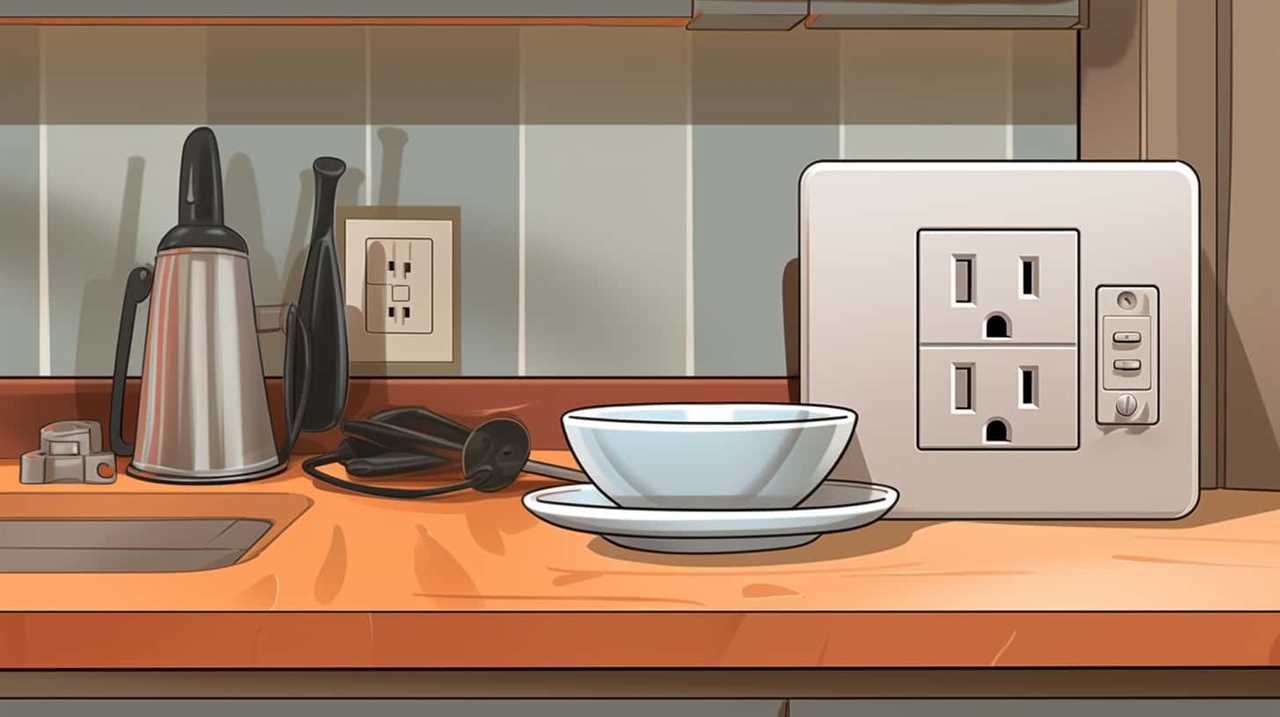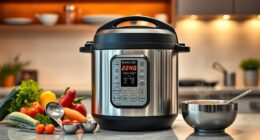Are you aware of the significant impact that the lifespan of our household appliances can have on our daily routines? Whether it’s refrigerators or coffee makers, knowing the longevity of these essential items is essential for ensuring a smoothly running household.
In this article, we will delve into the average lifespans of various appliances, providing you with the knowledge you need to make informed decisions and ensure the longevity of your investments.
So, let’s dive in and explore the world of appliance durability together.
Key Takeaways
- Appliances such as refrigerators, dishwashers, washing machines, dryers, and ovens typically have a lifespan of 10 to 15 years.
- Factors such as heavy usage, lack of maintenance, and the quality of the appliance can affect its lifespan.
- Regular maintenance tips for appliances include cleaning, checking and replacing seals, addressing issues promptly, and defrosting and cleaning freezers.
- Upgrading appliances can bring benefits such as improved energy efficiency, enhanced performance, increased safety features, and modern design.
Refrigerators
Refrigerators typically last around 10 to 15 years before they start experiencing significant issues. The lifespan of refrigerators can vary depending on factors such as usage, maintenance, and brand quality. Common problems with refrigerators include temperature inconsistencies, excessive noise, water leakage, and faulty door seals.

These issues can lead to spoiled food, increased energy consumption, and potential damage to the refrigerator’s internal components. Regular maintenance, such as cleaning the condenser coils and checking the door seals, can help prolong the lifespan of a refrigerator and prevent common problems. However, even with proper care, refrigerators will eventually reach a point where repairs become costly and frequent.
As we transition into the subsequent section about dishwashers, it’s important to consider the lifespan and common issues of these appliances as well.
Dishwashers
Moving on to dishwashers, these appliances also have a lifespan that can be influenced by various factors. Here are some key points to consider when it comes to the lifespan of a dishwasher:
- Quality of construction: A well-built dishwasher with high-quality components and materials is likely to last longer than one that’s poorly constructed.
- Regular maintenance: Proper cleaning and maintenance can help extend the lifespan of your dishwasher. This includes cleaning the filter, checking for clogs, and ensuring the spray arms are functioning properly.
- Water quality: Hard water can cause mineral buildup and damage the internal components of a dishwasher. Using a water softener or descaling agent can help mitigate this issue.
- Troubleshooting common dishwasher problems: Familiarize yourself with common dishwasher problems, such as leaks, poor cleaning performance, or unusual noises. Knowing how to troubleshoot these issues can help prolong the lifespan of your dishwasher.
Washing Machines
We have found that washing machines can have varying lifespans depending on several factors. The average lifespan of a washing machine is around 10-15 years, but this can be influenced by frequency of use, maintenance, and the quality of the machine itself.

Common problems with washing machines include issues with the motor, drum, or control panel. Motor problems may result in the machine not spinning or agitating properly, while drum issues can lead to leaks or excessive noise. Control panel malfunctions can cause the machine to not start or stop mid-cycle.
Regular maintenance, such as cleaning the drum and filters, can help prolong the lifespan of a washing machine. Additionally, using the machine according to the manufacturer’s instructions and addressing any issues promptly can also help prevent major problems and extend the lifespan.
Dryers
Dryers typically last around 10-15 years with regular use and proper maintenance. Here are four essential points to consider when it comes to dryer longevity:
- Clean the lint trap: Regularly removing lint from the trap not only improves dryer performance but also prevents the risk of fire hazards. Neglecting this simple task can lead to decreased airflow and increased drying times.
- Maintain the vent system: A well-maintained vent system ensures proper airflow, reducing strain on the dryer motor and extending its lifespan. Regularly inspecting and cleaning the vent ducts and exhaust vent will help maintain the efficiency of your dryer.
- Check for energy efficiency: Opting for an energy-efficient dryer can significantly impact its lifespan. Energy-efficient models use less energy, resulting in less wear and tear on components over time.
- Proper installation: Ensure your dryer is installed correctly, following manufacturer guidelines and using the appropriate electrical and venting connections. This will help prevent unnecessary strain on the machine and ensure its optimum performance.
Ovens
When it comes to ovens, understanding their lifespan is crucial. Ovens typically last between 10 to 15 years, depending on usage and maintenance.

Regular cleaning and proper maintenance can significantly extend the lifespan of your oven. Additionally, upgrading to newer models can offer more energy efficiency and advanced features, making it worth considering when your outdated oven starts showing signs of wear and tear.
Lifespan of Ovens
On average, ovens have a lifespan of 10 to 15 years. However, several factors can influence the longevity of an oven. Here are four important lifespan factors to consider:
- Usage: The more often you use your oven, the shorter its lifespan may be. Excessive use can put strain on the heating elements and other components, leading to faster wear and tear.
- Maintenance: Regular maintenance can extend the life of your oven. Cleaning the interior and exterior, replacing worn-out parts, and ensuring proper ventilation can all contribute to its longevity.
- Quality: The quality of the oven plays a significant role in its lifespan. Generally, higher-quality ovens are built to last longer and withstand heavy use.
- Signs of wear and tear: Keep an eye out for signs of wear and tear, such as inconsistent heating, strange noises, or faulty controls. These can indicate underlying issues that may shorten the lifespan of your oven.
To ensure the longevity of your oven, proper maintenance is crucial. Now, let’s delve into the topic of maintenance for longevity.
Maintenance for Longevity
Regular maintenance is essential for extending the lifespan of our ovens. By following a few simple maintenance tips, we can minimize the risk of breakdowns and ensure our ovens operate efficiently for years to come.

One of the most common causes of appliance breakdowns is neglecting to clean the oven regularly. Grease, food particles, and spills can accumulate over time and affect the oven’s performance. To prevent this, it’s important to clean the oven regularly using mild cleaners and non-abrasive materials.
Another crucial maintenance task is checking and replacing oven seals when necessary. Damaged or worn-out seals can cause heat loss, leading to longer cooking times and increased energy consumption. It’s recommended to inspect the seals periodically and replace them if they’re cracked or no longer provide a tight seal.
In addition to cleaning and inspecting the seals, it’s important to address any issues promptly. This includes addressing strange noises, unusual smells, or any sudden changes in performance. By addressing these issues early on, we can prevent further damage and potentially costly repairs.
Upgrading Outdated Models
To maximize the efficiency and functionality of our kitchens, it’s crucial that we consider upgrading our outdated oven models. Upgrading our ovens can bring numerous benefits that will enhance our cooking experience. Here are four reasons why upgrading our ovens is worth considering:

- Improved Energy Efficiency: Newer oven models are designed to be more energy-efficient, helping us reduce our electricity consumption and lower our utility bills.
- Enhanced Cooking Performance: Upgraded ovens often come with advanced features such as convection cooking and precise temperature control, allowing us to achieve better cooking results.
- Increased Safety Features: Newer oven models include safety features like automatic shutoff and cool-touch surfaces, reducing the risk of accidents and providing peace of mind.
- Modern Design and Aesthetics: Upgrading our ovens can give our kitchen a fresh and modern look, enhancing the overall appeal and value of our home.
Considering these upgrading benefits and cost considerations, it’s clear that investing in a new oven can greatly improve our cooking experience.
Now, let’s move on to discuss the next appliance on our list: microwaves.
Microwaves
We’ve found that microwaves typically last around 9-10 years, but this can vary depending on usage and maintenance. Microwaves have a limited lifespan due to the wear and tear they experience from regular use.
Over time, common issues may arise that can affect the performance and functionality of the microwave. One common issue is a malfunctioning control panel, which can make it difficult to set the desired time and temperature. Another issue is a faulty door latch, which can lead to inconsistent heating or even a complete failure to operate.

Additionally, the microwave’s internal components, such as the magnetron and capacitor, may wear out over time, resulting in decreased heating efficiency.
Regular cleaning and proper maintenance can help extend the lifespan of a microwave and reduce the likelihood of these common issues occurring.
Freezers
Moving on to freezers, our experience has shown that they typically have a lifespan of around 12-15 years, depending on usage and maintenance.
When it comes to energy efficiency, it’s important to consider the age of the freezer. Older models tend to be less energy-efficient compared to newer ones that are designed to meet stricter standards. If energy efficiency is a priority, look for freezers with ENERGY STAR certification.

Another factor to consider is the storage capacity. Freezers come in various sizes, so it’s crucial to assess your needs before purchasing one. A larger storage capacity may be ideal for families or those who frequently buy in bulk, while a smaller one may suffice for individuals or smaller households.
Keep in mind that proper maintenance, such as regular defrosting and cleaning, can help extend the lifespan of your freezer.
Air Conditioners
When it comes to air conditioners, our experience has shown that they typically have a lifespan of around 10-15 years, depending on usage and maintenance. Proper air conditioner maintenance is crucial to ensure optimal performance and longevity. Regularly cleaning or replacing air filters, checking and cleaning the condenser coils, and inspecting the refrigerant levels are essential maintenance tasks. Neglecting these tasks can lead to common air conditioner problems such as reduced cooling efficiency, inadequate airflow, and even complete system breakdown. The table below provides an overview of these maintenance tasks and the recommended frequency for performing them:
| Maintenance Task | Frequency |
|---|---|
| Cleaning or replacing filters | Every 1-3 months |
| Checking and cleaning condenser coils | Annually |
| Inspecting refrigerant levels | Annually |
Water Heaters
For water heaters, our experience has shown that they typically have a lifespan of around 8-12 years, depending on usage and maintenance. Here are four key points to consider when it comes to water heaters:

- Regular Water Heater Maintenance: To extend the lifespan of your water heater, it’s crucial to perform regular maintenance. This includes draining and flushing the tank annually to remove sediment buildup, checking the pressure relief valve, and inspecting the anode rod for corrosion.
- Energy Efficiency: Upgrading to an energy-efficient water heater can help reduce energy consumption and lower your utility bills. Consider investing in a tankless water heater or a high-efficiency model that meets ENERGY STAR® requirements.
- Temperature Settings: Adjusting the temperature settings on your water heater can have a significant impact on its lifespan and energy usage. Lowering the temperature to 120°F (49°C) can help prevent excessive strain on the unit and reduce the risk of scalding.
- Professional Installation: Proper installation is crucial for optimal water heater performance and longevity. Hiring a professional to install your water heater ensures that it’s correctly connected, vented, and calibrated, minimizing the risk of future issues.
Now, let’s move on to the next topic: garbage disposals.
Garbage Disposals
While garbage disposals can vary in lifespan, it’s important to understand how to properly maintain and care for them to ensure their longevity. When it comes to garbage disposal installation, it’s crucial to follow the manufacturer’s instructions precisely. This includes making sure all electrical connections are secure and that the disposal is correctly attached to the sink drain.
Regular maintenance is key to keeping your garbage disposal in good working condition. Avoid putting large amounts of food waste or hard materials down the disposal, as this can cause damage. Additionally, running cold water before, during, and after using the disposal can help prevent clogs and improve its performance.
If you encounter any issues, troubleshooting garbage disposals can involve checking for blockages, resetting the unit, or calling a professional for assistance. By following these guidelines, you can maximize the lifespan of your garbage disposal and ensure it continues to function efficiently.

Coffee Makers
To properly maintain and maximize the lifespan of our coffee makers, we should adhere to the manufacturer’s instructions and perform regular maintenance. Here are four key tips to ensure the longevity and optimal performance of your coffee maker:
- Cleaning: Regularly clean your coffee maker, including the carafe, filter basket, and water reservoir, to remove any buildup of coffee oils and mineral deposits. This will prevent clogs and maintain the taste of your coffee.
- Descaling: Over time, mineral deposits can accumulate inside the coffee maker, affecting the brewing process. Descaling the machine periodically, as recommended by the manufacturer, will remove these deposits and ensure consistent performance.
- Use high-quality water: Using filtered or bottled water instead of tap water can prevent mineral buildup and extend the lifespan of your coffee maker.
- Troubleshooting: Familiarize yourself with common issues and their solutions. This includes understanding error codes, checking for loose connections, and consulting the manufacturer’s troubleshooting guide.
Toasters
When it comes to the lifespan of our toasters, we should adhere to proper maintenance guidelines and follow these tips.
To extend the lifespan of your toaster, regular cleaning is crucial. Crumbs and food particles can accumulate over time, leading to a decline in performance and potential safety hazards.
To clean your toaster, unplug it and wait for it to cool down. Remove the crumb tray and discard any debris. Use a soft brush or cloth to gently wipe the interior and exterior of the toaster. Avoid using abrasive cleaners or submerging the toaster in water.

Additionally, regularly check the heating elements for any signs of damage or wear.
Frequently Asked Questions
How Often Should I Clean the Condenser Coils of My Refrigerator?
We should clean the condenser coils of our refrigerator regularly as part of our refrigerator maintenance routine. This helps to prevent dust and debris buildup, ensuring optimal performance and extending the lifespan of the appliance.
Can I Use Regular Dish Soap in My Dishwasher?
Regular dish soap should not be used in a dishwasher. It can cause excessive sudsing and damage the machine. To ensure proper maintenance, use a dishwasher detergent specifically designed for the appliance.
How Often Should I Clean the Lint Trap in My Dryer?
To properly clean the lint trap in a dryer, we should regularly remove the accumulated lint. Doing so improves airflow, reduces fire hazards, and enhances the efficiency of the dryer. It’s essential for maintaining optimal performance.

Is It Safe to Use Aluminum Foil in My Oven?
Yes, aluminum foil is safe for use in your oven. However, it’s important to follow safety guidelines and not allow it to come into contact with heating elements. To clean your oven without harsh chemicals, try using a mixture of baking soda and vinegar.
How Often Should I Replace the Air Filter in My Air Conditioner?
We should regularly replace the air filter in our air conditioner to ensure optimal performance and clean air circulation. This maintenance task is essential, just like changing the water filter in our refrigerator and using a dehumidifier for a healthier home environment.
Conclusion
In conclusion, appliances have varying lifespans depending on their type and usage. Refrigerators can last up to 15 years, while dishwashers and washing machines typically last around 10 years. Dryers and ovens have a lifespan of approximately 13-15 years. Water heaters and garbage disposals last around 10-15 years. Coffee makers and toasters, on the other hand, have a shorter lifespan of 5-10 years.
So, when investing in appliances, consider their longevity to make informed decisions.











